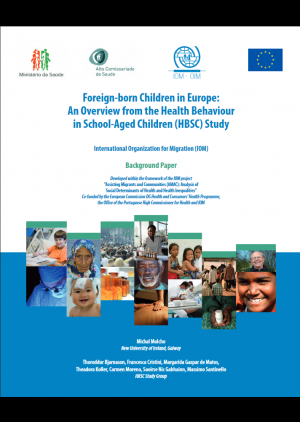Introduction: The background paper presented here is based on findings from the Health Behaviour in School-Aged Children (HBSC) Study. The HBSC research network is an international, multidisciplinary alliance of researchers working together since 1982. In 2005/6, 41 countries and regions in Europe and North America collected data as part of the HBSC Study. The overall aim of the study is to gain new insights and increase understanding of adolescent health behaviour. Twelve countries of the network (Flemish-speaking Belgium, Germany, Denmark, Spain, Greece, Ireland, Iceland, Italy, Scotland, Sweden, Wales and Portugal) included questions on children’s immigration status and these are included in the situation analysis of this paper. Additionally, five of this countries provided in-depth national case studies.
Situation analysis: The proportion of child immigrants in the participating countries ranged from 4% in Wales to 11% in Ireland. In all countries, child immigrants were similar to their native peers in relation to age and gender distribution; however, in all countries, child immigrants were more likely to live in low socio-economic households. No clear cross-national patterns are found in relation to general health, relationship with parents and friends, school perceptions or involvement in risk behaviours. In some countries child immigrants fared better than their native peers; in other they are similar to their peers, and in some they fare worse.
National case studies: The background paper includes five national case studies, allowing for a more detailed analysis of child immigrants’ experiences. Iceland has analysed cultural and linguistic predictors of difficulties in school and of involvement in risk behaviours among child immigrants. Ireland reviewed health inequalities in three groups of children in Ireland: child immigrants from the UK, child immigrants from non-UK countries and children from the Irish Traveller communities. Italy explored risk behaviour in immigrant children and the effect of family monitoring on such behaviours. Portugal looked at nationality versus poverty, looking at findings and recommendations regarding interventions on migrant adolescents. Finally, Spain focused on policies and practices for migrant children.
Conclusions: The findings highlight mainly two different issues. The first is that child immigrants across the board are more likely to live in low socio-economic households, and thus are more disadvantaged than their native peers. Child immigrants are also at a higher risk for social exclusion. The second issue is the lack of one clear message regarding child immigrants’ health and experiences. Findings in this paper highlight the complexity of the immigration phenomenon and its different aspects predicting health and health behaviour (e.g. country of origin, country of residence, fluency in the language of country of residence and more). These findings strongly stress the need for more focused studies on child immigrants, looking at different groups, at country of origin and country of residence, potentially by comparing specific immigrant groups across countries.
